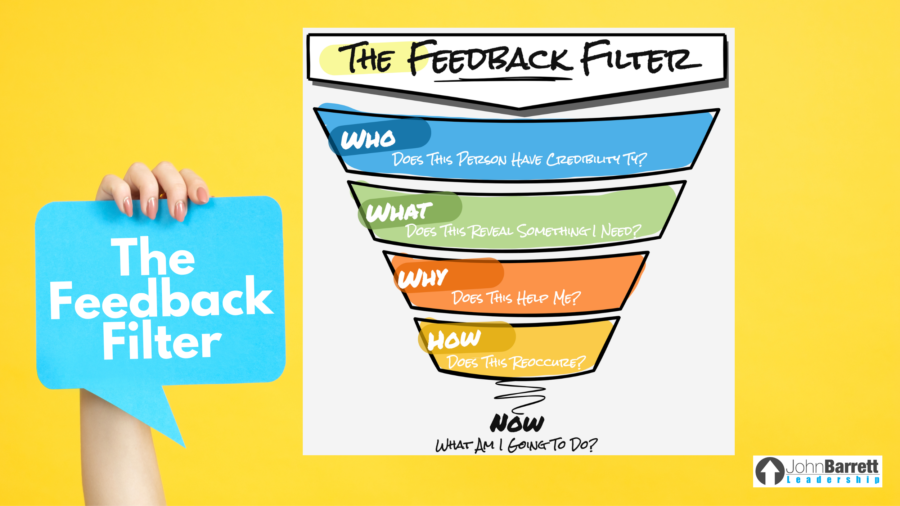The Feedback Filter
All feedback we receive must be filtered through a process to ensure its maximum impact on our growth. All feedback is not necessarily the right feedback. We have to understand the variables that play into knowing how to receive feedback properly. I have developed a series of five questions you have to run all communication through as you process it…I call it the Feedback Filter.
Let’s break down the five questions:
1) Who Said It?
You have to filter feedback first from who gave it to you. The source of feedback can have a significant impact on the effectiveness and usefulness of the feedback. Feedback from someone who has the right to speak can be highly valuable as it comes from a position of knowledge and experience. This feedback can provide a better understanding of the strengths and weaknesses and help you make the necessary improvements.
On the other hand, feedback from someone who does not understand the situation may not be as useful or relevant. Such feedback can be biased, uninformed, and may not align with your goals and aspirations for the future.
2) What Was Said?
Always consider the content of the feedback you receive. Evaluate whether it’s specific, actionable, and relevant to your role as a leader. Try to find the gold nugget you need to extract from what is being said. Receiving feedback can be a challenging experience, especially if you don’t agree with the feedback being provided. However, it’s important to remember that feedback is an opportunity for growth and development, even if you don’t fully agree with it.
Here are some tips for receiving feedback, even if you don’t agree with it:
- Listen actively: Give the person providing the feedback your undivided attention. Make eye contact, nod your head, and ask questions to show that you are engaged and interested in what they have to say.
- Clarify and ask questions: If you don’t fully understand the feedback or disagree with it, ask the person providing the feedback to clarify or provide examples. This can help you gain a better understanding of their perspective and identify areas for improvement.
- Avoid becoming defensive: It’s natural to feel defensive when receiving feedback, especially if it’s critical or negative. However, becoming defensive can prevent you from truly hearing and considering the feedback. Instead, take a deep breath, stay calm, and try to remain open-minded.
- Reflect on the feedback: You may not completely agree with all that is said, but you must reflect on what may be contributing to the other person’s perception of your behavior. Reflect on the feedback objectively and consider if there may be some truth to it, even if you don’t fully agree. Look for patterns or trends in the feedback that may point to areas for improvement.
3) Why Was It Said?
It’s also important to consider the intention behind the feedback. Feedback that is provided constructively with the intention of helping you improve can be highly beneficial. However, feedback that is provided with the intention of putting you down or making you feel inferior can be harmful and unproductive.
Here are signs of constructive feedback or destructive feedback:
- Constructive feedback is balanced and fair, acknowledging both positive and negative aspects of the situation. Destructive feedback is often one-sided and ignores any positive contributions or achievements.
- Constructive feedback focuses on specific behaviors or actions that can be improved, while destructive feedback attacks the person and their character.
- Constructive feedback is relevant to the situation and objective in nature, while destructive feedback may be based on personal biases or emotions.
- Constructive feedback is specific and actionable, with suggestions for improvement. Destructive feedback is vague, unhelpful, and doesn’t offer any guidance on how to improve.
4) How Many Times Has It Been Said?
Factoring in how many times you have received the same feedback is an important consideration when it comes to improving as a leader. Consistent feedback from multiple sources is a strong indication that there may be an area for improvement that needs to be addressed. When you receive consistent feedback from multiple sources, it can help you identify patterns in your behavior that may be impacting your effectiveness as a leader.
If the feedback you are receiving is new and has never been communicated by anyone else, you need to factor that in as well. It certainly does not discredit the feedback, it is just an indicator of how important or urgent your response to the feedback should be. Pay attention to how often you receive similar feedback.
5) Now, What Are You Going To Do?
It is not enough to simply receive feedback; you must also take action on it to make meaningful changes and improve as a leader. Knowledge without action is useless. The only way you can improve is to take action and apply new behaviors.
Here are some tips on what to do with the feedback you receive:
- Embrace the feedback and acknowledge that there is room for improvement. Recognize that the feedback is a gift that can help you become a better leader.
- Identify specific behaviors to change based on the feedback you have received. Be specific and actionable in your approach.
- Develop a plan of action for changing these behaviors. Set realistic and achievable goals, and establish a timeline for achieving them.
- Seek support from mentors, colleagues, or coaches who can provide guidance and accountability. Share your plan of action with them, and ask for feedback and support as you work to change your behaviors.
- Monitor your progress regularly to see how you are doing. Celebrate successes, and make adjustments as needed.
- Changing yourself based on feedback takes time, and it may not happen overnight. Be patient with yourself, and continue to work toward your goals.
Utilize the Feedback Filter, and you’ll know no limits to your leadership growth.










